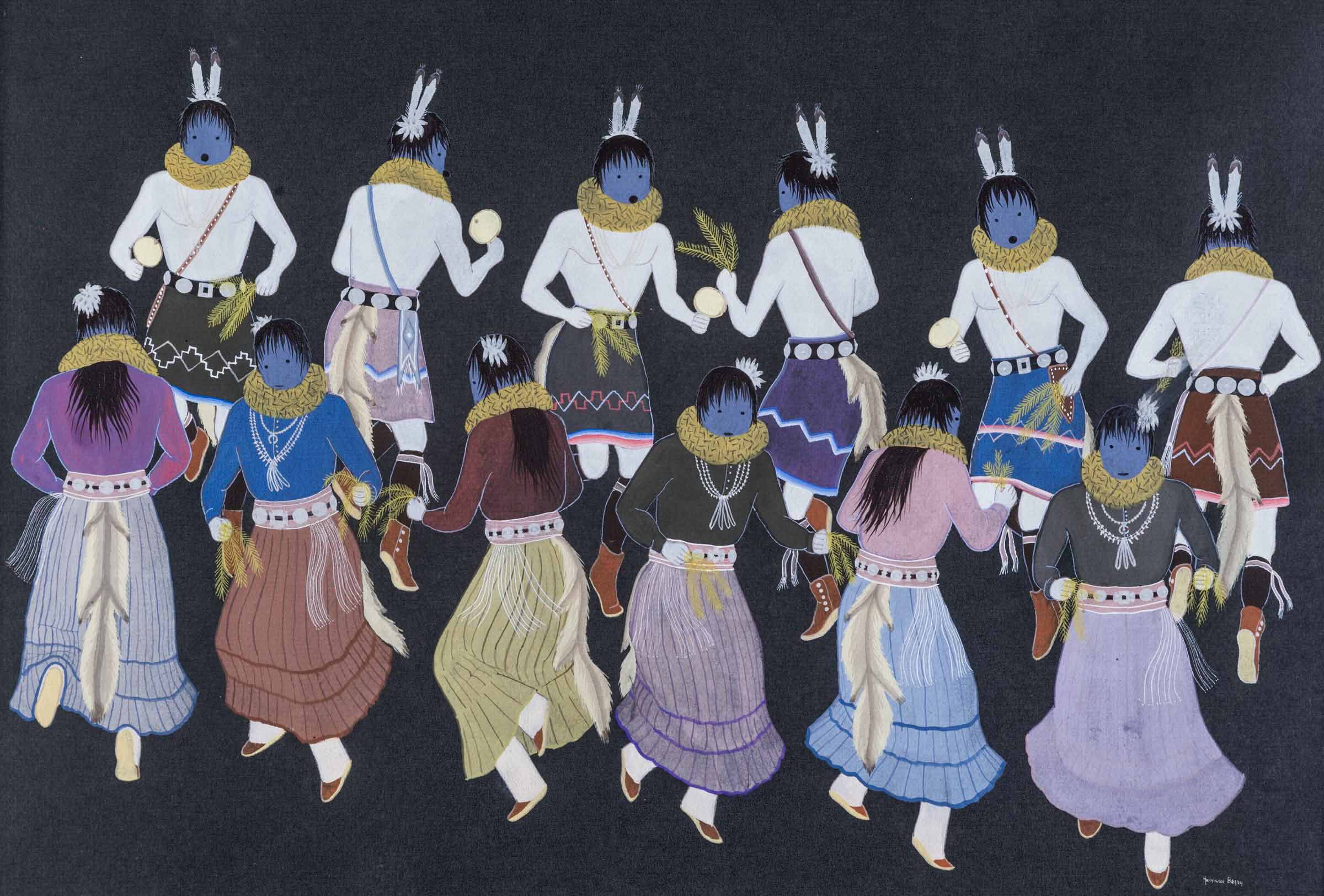Home » Special Exhibits » The Art and Artists of “The Indian New Deal” » The Studio Style
The Art and Artists of “The Indian New Deal”
The Studio Style
In New Mexico, many Native New Deal artists were trained in and worked in “The Studio Style,” a contradictory methodology that both promoted and limited the concept of Native art, reflecting the broader socio-political context of the era.
At First Glance
Compare and contrast these paintings by four different Native artists.
What do they have in common? What is different?

Click to view artist Jerry Brown’s Guest-Curated Tour.
Looking Closer
Style
Gallup’s New Deal art collection represents Native artists from three different cultures, yet their paintings are very similar. Why?
All four—Allan Houser (Chiricahua Apache), Harrison Begay (Diné/Navajo), Timothy Begay (Diné/Navajo), and Jose Rey Toledo (A:shiwi/Zuni)—were trained in the “Studio Style” of painting. The Studio Style was institutionalized by non-Native art teacher Dorothy Dunn, who founded the Santa Fe Indian School’s painting program, which became known as The Studio, in 1932, and directed it until 1937. Houser, Harrison Begay, and Timothy Begay1 attended The Studio during Dunn’s tenure.2Toledo did not study with Dunn, but received instruction in the Studio Style as a student at the Albuquerque Indian School.
Read More
While Dunn was progressive in important respects, most notably by encouraging students to depict their cultures before the US government officially repealed its assimilationist educational policies, she subscribed to primitivist ideology.3 Dunn believed that there was an “authentically Indian” way to paint, demonstrated in the wall paintings, rock art, and pottery designs of the ancient peoples of the Southwest and the hide paintings and ledger art of Plains Indians. Using these and related prototypes,4 she designed a formal, methodical training program that intentionally rejected (in Dunn’s words) “European traditions of painting such as light and shade, perspective, anatomy, the use of models, etc.”5 and that championed a flat, linear style as the truest and highest form of “Indian painting.” While Dunn believed she was tapping into students’ innate artistic abilities and deeply rooted forms of cultural expression, her curriculum led students down a prescribed aesthetic path.
The Studio was met with immediate acclaim by the art world establishment—students had a show at the New Mexico Museum of Art their second semester, the Denver Art Museum almost immediately began collecting their work, and Dunn started fulfilling requests for traveling exhibitions nationally and, within two years, internationally (by 1937 The Studio School had been exhibited from the Brooklyn Museum to the San Francisco Museum of Art in the United States and in Paris, Prague, Budapest, and other European cities). By the end of the 1930s, The Studio program became the standard instructional approach to art education in Native American boarding schools across the country. Soon, it proved so commercially successful—meeting the expectations of collectors and tourists seeking “genuine” Native American art—that it did not need to be taught but became internalized. It is distinguished by the following:
- Outlined, flat fields of opaque color
- Two-dimensionality
- Blank backgrounds
- Illustrative portrayals of Native ceremonies, customs, and lifeways (Dunn generally guided students to redact elements of modern life and eschew signs of conflict or social strife)
- Sometimes the inclusion of Native American symbols
Seeing Past
CONTEXT
While the Studio Style appears to present culture in a visual vacuum, it is actually a product of its socio-historical context. In 1934, the US Congress passed the Indian Reorganization Act (IRA), the most significant reform in federal policy toward Indigenous peoples in over a century. The IRA was the centerpiece of the Indian New Deal, or, as some Indigenous leaders would refer to it, the “Indian Raw Deal.” In principle, the IRA was meant to reverse policies of assimilation and promote tribal self-determination. In reality, the IRA maintained US hegemony.
Read More
A key feature of the act was to enable tribal self-government. Yet the act permitted only the adoption of a uniform written constitution that mirrored that of the United States and was formulated by the Department of the Interior with practically no input from Indigenous leaders. IRA constitutions also provided for continued federal oversight of tribal governments.
The parallels between the IRA and the Studio Style are striking: both embody the ideological tensions of the era. The urge to promote Native cultures was distorted by the misguided compulsion to distill a diversity of cultures into a singular, romanticized, and static ideal. Similarly, efforts to encourage self-sufficiency were undermined by a penchant for paternalism.
These contradictory trends are likewise embodied in the early 20th-century art market, which also influenced the Studio Style. In its quest for “authentic” Indigenous culture, the market forced creative output into one mold, ultimately boxing in self-expression within a narrow definition of “Indian art” in order to package and sell it.
Yet, just as tribal leaders negotiated federal policy within the Indian New Deal—not all adopted the IRA constitution, for instance—Native artists also exercised agency within New Deal art programs.
Tradition of Creativity
Native artists belong to a tradition of creativity. As scholars have well argued, “Indian art” is a false construct that has, in the words of one, “legislated a particular visual style as the benchmark for Native art” for over a century.6 In his essay “What Is Native American Art?” Edwin Wade writes that “If we should ever succeed in truly defining Indian art, that definition would be an epitaph. But if we remove the restraints of stereotype and allow the creative impetus full rein, we can observe the development of an exciting art that draws on the richness of its own past as it continually recreates itself for the future.”7
The successor to The Studio School is the Institute of American Indian Arts (IAIA).8 In its inaugural exhibition, Creativity Is Our Tradition, IAIA espoused values that unravel Dunn’s legacy. As Rick Hill wrote for the catalog: “Tradition is not the replication of style, but the creative interpretation of the foundations of belief and thinking.”9
It is true that the Studio Style played a fundamental role in contriving “Indian art” as a fixed category and artificial standard, and that New Deal Native artists were largely pigeonholed by educational and economic forces. It is also true that these artists are part of a “tradition of creativity,” using the tools at their disposal to express themselves, to tell their stories, and to share their voices.




